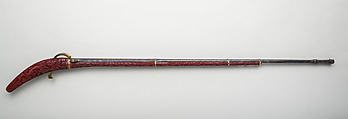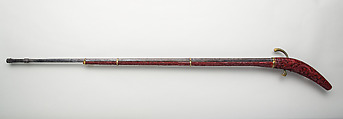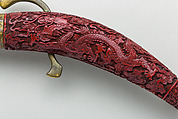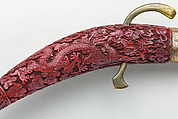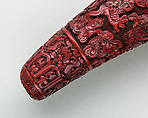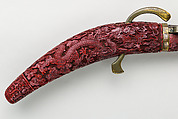On loan to The Met The Met accepts temporary loans of art both for short-term exhibitions and for long-term display in its galleries.
Matchlock Gun with Carved Red Lacquer Stock
Although typical in its form, this gun is extraordinary, possibly unique, for its decoration, consisting of deeply carved red lacquer covering the entire gunstock and featuring designs of undulating dragons among billowing clouds. This painstaking, delicate, and expensive lacquer technique is usually found on dishes, boxes, and other types of lacquerware intended as presentation pieces or to be appreciated as works of art. Additional ornament is visible on the gun barrel, which is finely engraved along its length with images of dragons and leafy vines.
China pioneered the use of gunpowder for fireworks and artillery in the thirteenth and fourteenth centuries. Sophisticated firearms technology, however, developed more rapidly in Europe during the fifteenth and sixteenth centuries and was then introduced into China by merchants, diplomats, and missionaries during the seventeenth century. Improved designs for cannons and practical types of hand-held guns were eagerly promoted and officially adopted as regulation military equipment under the Qing emperors Kangxi (reigned 1662–1722) and Qianlong (reigned 1736–1795). In addition to mastering the use of bow and arrow and other weapons, both Kangxi and Qianlong owned and used guns, particularly for hunting. This was in keeping with their overall belief in the importance of martial training, which they encouraged by personal example.
Due to rights restrictions, this image cannot be enlarged, viewed at full screen, or downloaded.
This artwork is meant to be viewed from right to left. Scroll left to view more.
